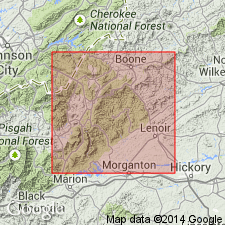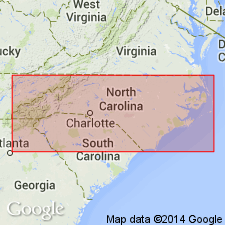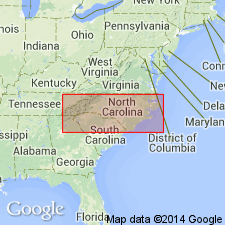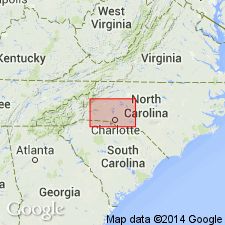
- Usage in publication:
-
- Brown Mountain Granite*
- Modifications:
-
- Named
- Dominant lithology:
-
- Granite
- AAPG geologic province:
-
- Piedmont-Blue Ridge province
Summary:
Named for exposures on Brown Mountain, northeastern part of Linville 15-min quad, northwestern NC. Occurs in Grandfather Mountain window. Consists of light-colored, medium- to coarse-grained, poorly foliated, nonlayered, homogeneous granite. Exhibits distinct cataclastic lineation. Crops out in exfoliation slabs. Contains local thin zones of silvery gray phyllonite. Faulted against Wilson Creek Gneiss and upper Precambrian sedimentary and volcanic rocks on the west and northwest; bounded by Linville Falls fault to the southeast. Report includes geologic map and correlation chart. Relationship to Wilson Creek Gneiss and Blowing Rock Gneiss is undetermined, but all three units are inferred to be of Precambrian age.
Source: GNU records (USGS DDS-6; Reston GNULEX).

- Usage in publication:
-
- Brown Mountain Granite*
- Modifications:
-
- Age modified
- AAPG geologic province:
-
- Piedmont-Blue Ridge province
Summary:
Dikes of Brown Mountain Granite cut Blowing Rock Gneiss and Wilson Creek Gneiss northeast of Adams Mountain. Although these are the only intrusive relationships between the three rocks observed, map pattern, sharp contacts, uniformity of composition, and highly perthitic character of potassium feldspar in Brown Mountain Granite support this interpretation. This revises a statement in the naming paper by Reed (1964) which assumes all three units are the same general age. Age of Brown Mountain is late Precambrian. Age of Blowing Rock and Wilson Creek Gneisses is early Precambrian.
Source: GNU records (USGS DDS-6; Reston GNULEX).

- Usage in publication:
-
- Brown Mountain Pluton
- Modifications:
-
- Age modified
- Revised
- Geochronologic dating
- AAPG geologic province:
-
- Piedmont-Blue Ridge province
Summary:
Name used as Brown Mountain Pluton of Crossnore plutonic suite. U-Pb dating for zircons from Brown Mountain Pluton shows that the rock cannot be more than 735 m.y. old. This age is too high because of inherited zircons. Rounded clasts of Brown Mountain granite are incorporated in flows of Grandfather Mountain Formation (Bryant and Reed, 1962). Unless the clasts were rounded by transport in lava, time interval between Brown Mountain granite crystallization and Grandfather Mountain Formation deposition must have been long enough to allow for exhumation of the Brown Mountain Pluton prior to volcanic activity. These conclusions lead authors to believe that the 820 m.y. age of the Grandfather Mountain Formation, Mount Rogers Formation, and Catoctin Formation reported by Rankin and others (1969) was erroneously high.
Source: GNU records (USGS DDS-6; Reston GNULEX).

- Usage in publication:
-
- Brown Mountain Granite
- Modifications:
-
- Not used
- AAPG geologic province:
-
- Piedmont-Blue Ridge province
Summary:
Brown Mountain Granite not used in map explanation. Instead, map shows Late Proterozoic (680-710 m.y.) metamorphosed granite, but states that it is equivalent to Brown Mountain Granite.
Source: GNU records (USGS DDS-6; Reston GNULEX).

- Usage in publication:
-
- Brown Mountain Granite*
- Modifications:
-
- Revised
- AAPG geologic province:
-
- Piedmont-Blue Ridge province
Summary:
Crossnore Plutonic-Volcanic Complex revised as Crossnore Complex because Crossnore contains two classes of rocks, sedimentary and igneous (North American Code of Stratigraphic Nomenclature, 1983, art. 37). On map, includes only Brown Mountain Granite and Linville Metadiabase. Authors do not include Grandfather Mountain Formation in Crossnore Complex in map explanation, but note in a footnote that it was included by Rankin and others (1973). [This was probably a mistake; Grandfather Mountain Formation should have been included in Crossnore Complex in this report.] Age is Late Proterozoic.
Source: GNU records (USGS DDS-6; Reston GNULEX).
For more information, please contact Nancy Stamm, Geologic Names Committee Secretary.
Asterisk (*) indicates published by U.S. Geological Survey authors.
"No current usage" (†) implies that a name has been abandoned or has fallen into disuse. Former usage and, if known, replacement name given in parentheses ( ).
Slash (/) indicates name conflicts with nomenclatural guidelines (CSN, 1933; ACSN, 1961, 1970; NACSN, 1983, 2005, 2021). May be explained within brackets ([ ]).

